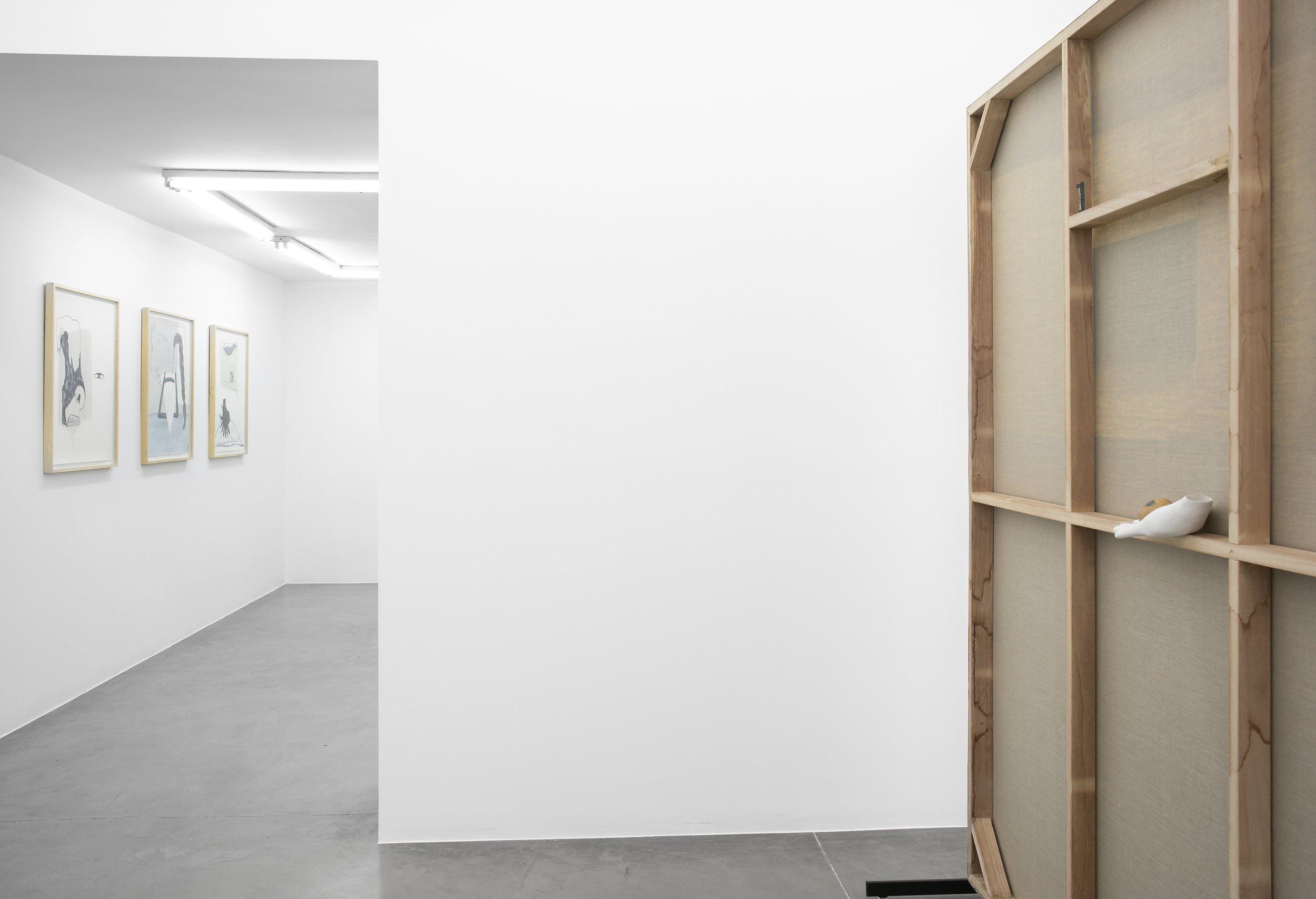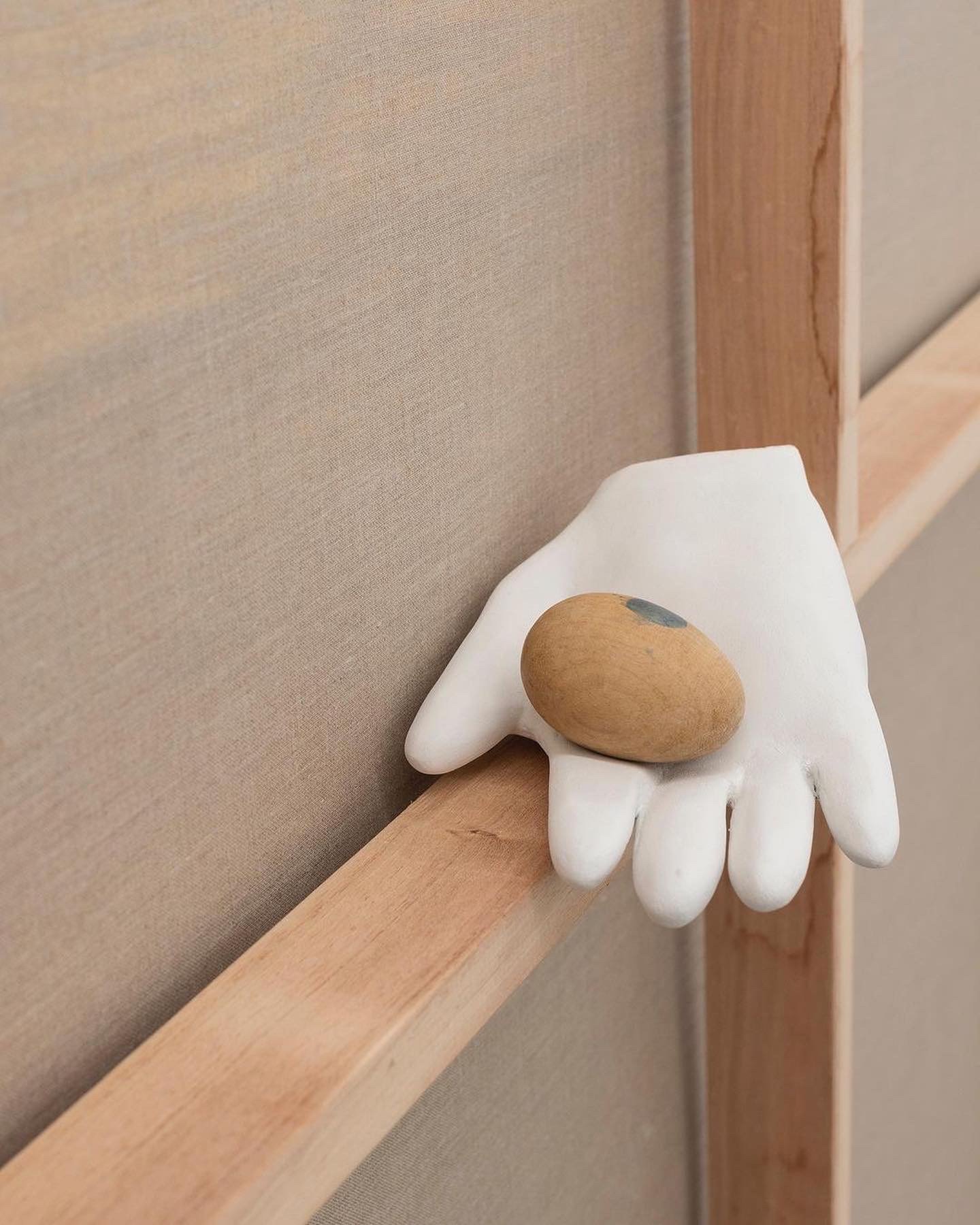GALERIA HACHE, Buenos Aires, March 2023
Curated by Laura Hakel
EXHIBITION VIEW
Gallery images- Photo credits: Ignacio Iasparra
PRESS RELEASE
La muestra "El cuerpo es Avant Garde” de Sofía Quirno en la galería HACHE, se compone de un conjunto de pinturas de gran escala, esculturas y animaciones que revisitan las relaciones entre el cuerpo, el tiempo y el deseo.
Frases y percepciones recogidas al transitar por la calle en el día a día, collages pintados provenientes de cuadernos en los que la artista trabaja hace más de doce años, y composiciones fragmentadas con referencias a tajos, huevos y ciclos, plantean en la muestra preguntas sobre cómo se programa y cómo se reprograma la autopercepción de un cuerpo en relación a su capacidad de gestar. En otras palabras, El cuerpo es Avant Garde, explora promesas, incomodidades, libertades y frustraciones en torno a cómo se moldean la subjetividad, la imaginación y las expectativas sobre el tiempo reproductivo de un cuerpo.
Con una práctica de taller en la que acopla distintas materialidades, Sofía Quirno presenta una instalaciones inmersivas centradas en pinturas donde los elementos en el espacio hacen ecos unos de otros. Sus obras citan referencias a mujeres absorbidas dentro de paisajes lunares y realizan homenajes a artistas como Sarah Lucas y Francesca Woodman que en el arte contemporáneo hicieron explotar huevos a su alrededor. Repletas de referencias metabolizan imágenes fragmentarias que aluden a situaciones irresueltas donde la toma de posicionalidad se centra en abrazar la duda. Montadas sobre estructuras escultóricas se presentan en la sala como mobiliario de una hospitalidad diseñada para la incomodidad y el humor.
—————————
El cuerpo es Avant Garde [The body is Avant Garde], Sofía Quirno’s current show at Hache galería, consists of a group of large-scale paintings, sculptures, and animations that reexamine the relationships between the body, time, and desire.
With phrases and perceptions born of circulating on the street every day, as well as painted collages from the notebooks in which the artist has worked for over twelve years and fragmented compositions with references to slashes, eggs, and cycles, the exhibition asks questions about how to program and how to reprogram the self-perception of a body in relation to its ability to gestate. In other words, El cuerpo es Avant Garde explores the promises and discomforts, freedoms and frustrations, tied to how subjectivity, imagination, and expectations regarding a body’s time of reproduction are shaped.
At play in Sofía Quirno’s studio practice is the joining of different materialities. Here, she exhibits immersive installations that revolve around paintings where the elements in the space resonate in one another. These works make reference to women in the midst of moons- capes and pay homage to artists like Sarah Lucas and Francesca Woodman who shook up the machismo and assumptions over the performance of bodies in the contemporary art scene.
The abundant references in these works metabolize fragmentary images suggestive of unre- solved situations where taking a stance entails embracing doubt. Mounted on sculptural structures, the works are displayed in the gallery like the furnishings of a hospitality designed both to jar us and to make us laugh.
WORKS
Work Photo credits Claudia Loayza Zárate
EXHIBITION TEXT
El huevo y la gallina
por Laura Hakel
“Yo siempre pienso que mi cuerpo es avant-garde” me dijo un día Sofia Quirno en su taller en Nueva York, mientras pasaba las hojas de sus cuadernos con dibujos y collages realizados hace más de doce años. En ellos aparecían huevos haciendo equilibrio, parados en pedestales y coreografiados formando líneas sinuosas que parecían no tener una dirección resuelta. La pregunta que resonaba en la conversación era, ¿cómo se programa y cómo se reprograma la imaginación del cuerpo en relación a su capacidad de gestar?
A veces es necesario rebobinar para hacer una auditoría de las obsesiones propias, heredadas e impuestas que el cuerpo metaboliza en el proceso de su actualización. Hace dos años, Sofía Quirno comenzó a revisar cuadernos. Sacó hojas, cortó partes y rompió pinturas para volver a unirlas y crear los bocetos de las obras que se presentan hoy en la galería Hache. En El cuerpo es avant-garde hay gallinas, relojes, metrónomos, tajos y formas ovoides que crean una constelación de ideas vinculadas a los ciclos del cuerpo.
La obra de Quirno tiene una lógica fragmentaria. Trabaja sustrayendo de su día a día frases e imágenes que quedan resonando en su cabeza y en su mirada. Por ejemplo, expresiones en inglés o en español que escucha caminando por la calle, mirando la tele o escuchando la radio. También incorpora espacios que observa mientras va a trabajar, suma referencias a otros artistas, e incluye objetos encontrados en sueños o producidos por su imaginación. Todos estos fragmentos van a parar a sus cuadernos para crear imágenes enigmáticas, algo irreales, como si fueran un cadáver exquisito de lo que el cuerpo y la percepción va filtrando durante el día.
La pintura Hay que andar liviana en este mundo, o no (2023) superpone dos obras anteriores dándole forma a un cuerpo oval absorbido dentro de un paisaje lunar. En Retrato hablado (2023), un elemento semejante a una cacerola aparece rebosante de huevos pintados en una paleta de colores fríos. Quizás no nos volvamos del todo indiferentes (2023), presenta una construcción parecida a un gallinero con ventanas ciegas y graffitis románticos del tipo “tu y yo”, en una mitad de la tela, y un espacio inteligible en la otra. La convivencia de dualidades, las interrupciones y las composiciones inestables en las pinturas de Quirno evocan promesas, incomodidades, libertades y frustraciones en torno a cómo se moldean la subjetividad, la imaginación y las expectativas sobre el tiempo reproductivo del cuerpo.
Su práctica de taller acopla distintas materialidades que terminan componiendo instalaciones inmersivas donde los elementos en el espacio hacen ecos unos de otros.
Las pinturas de gran formato se encuentran montadas sobre bastidores que, como repisas, sostienen fragmentos pequeños de otras pinturas y esculturas. Reunidas en la sala junto a objetos y animaciones, plantean tensiones entre espacios macro y micro, señalan relaciones vinculadas a lo móvil, lo dinámico y lo congelado, y proponen paradojas entre lo que se sostiene solo y lo que es sostenido.
En plena vanguardia surrealista, Francis Picabia equiparaba el cuerpo a la máquina y planteaba ironías sobre el automatismo productivo de la modernidad. En el caso de Sofía Quirno, El cuerpo es avant-garde contiene la idea de que el cuerpo va por delante en el saber de la razón. La muestra es una invitación a mirar cómo el flujo de los procesos vitales negocian con la mente, con los espacios que habitamos y con las imágenes.
A esta hora Sofía debe estar subiéndose al avión rumbo a Buenos Aires cargada con sus obras dispersas en su equipaje. “Todo lo que hago se puede doblar, transportar o guardar. Mi obra se tiene que poder enrollar, como una carpa que me acompaña.” La pintura de Sofía Quirno es su casa. En sus tiempos, afirmaciones y contradicciones, se habitan mutuamente.
——————————————
The Egg and the Chicken
By Laura Hakel
“I always think my body is avant-garde,” Sofia Quirno told me one day in her studio in New York while leafing through the notebooks of drawings and collages she worked on over twelve years ago. They feature eggs doing balance acts—standing on pedestals or doing choreographies of win- ding lines that don’t seem to know where they are headed. The question that resonated throughout our conversation was how to program and how to reprogram the imagination of the body in relation to its capacity to gestate.
It is sometimes necessary to rewind to take stock of our obsessions, whether passed down, imposed, or innate, obsessions that the body metabolizes in its process of renewal. Two years ago, Sofía Quirno began to reexamine her notebooks. She tore out whole pages, cut out parts, and ripped paintings only to put them back together to create the sketches for the works now on exhibit in Hache gallery. The chickens, clocks, metronomes, slashes, and ovals in El cuerpo es Avant Garde form a constellation of ideas tied to bodily cycles.
Quirno’s work has a fragmentary logic. Her process entails taking from her daily life phrases and images that resonate in her mind and her vision, expressions in English or in Spanish, say, that she hears while walking down the street, watching TV, or listening to the radio. She also incorporates spaces she sees on her way to work, references to other artists, as well as objects found in her dreams or produced by her imagination. All of those bits and pieces end up in her notebooks. With them, she creates enigmatic and somewhat unreal images, almost like a sort of exquisite corpse of what filters through the body and perception over the course of the day.
In the painting Hay que andar liviana en este mundo, o no [You Have to Travel Light through this World, Or Do You?] (2023), two earlier works are layered to give shape to an oval body in the midst of a moonscape. In Retrato hablado [Spoken portrait] (2023), eggs painted in cold tones flow copiously out of a snail-like element. One half of the canvas Quizás no nos volvamos del todo indife- rentes [Perhaps we won’t become completely indifferent] (2023) depicts a construction that looks like a henhouse with blind windows and romantic phrases such as “you and me” in graffiti-like print, and the other an intelligible space. The comingling of dualities, the interruptions, and the unstable compo- sitions in Quirno’s paintings suggest promises and discomforts, freedoms and frustrations regarding how subjectivity, imagination, and expectations about the reproductive time of the body are shaped. At play in Sofía Quirno’s studio practice is the joining of different materialities to compose immersive installations where the elements in the space resonate in one another.
The large-format paintings are mounted on stretchers that act as shelves, holding up small pieces of other paintings or of sculptures. Alongside the objects and animations in the gallery, the paintings formulate tensions between macro and micro spaces; they signal relations tied to the mobile, the dynamic, and the frozen, and propose paradoxes between things that stand on their own and things that must be propped up.
At the height of the surrealist avant-garde, Francis Picabia compared the body to a machine, making ironic reference to the productive automatism that came with modernity. Sofía Quirno’s El cuerpo es Avant Garde, meanwhile, posits that the body precedes the knowledge of reason. This show is an invitation to see how the flow of vital processes negotiates with the mind, with the spaces we inhabit, and with images.
At this very moment, Sofía must be getting on the plane for Buenos Aires, her works scattered through her luggage. “Everything I do can be folded, transported, or stored. My art has to be rollupable; it is like a tent I take with me.” Sofía Quirno’s painting is her home, one where affirmations and contradictions live side by side.

































